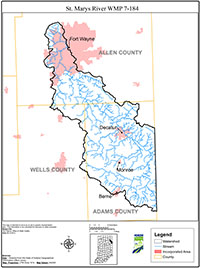Summary
The St. Marys River Watershed Management Plan (WMP) intends to provide a comprehensive, useful, flexible tool to address resource concerns in the watershed and to protect and enhance natural resources within the boundaries of the Indiana portion of the St. Marys River Watershed. Once completed, the WMP will provide improved living conditions, recreational opportunities, and environmental health benefits to residents who live and work within the watershed. Consequently, it will provide benefits to residents and communities throughout the Western Lake Erie drainage basin. This management plan was developed through a collaborative effort between the Adams, Allen, and Wells County Soil and Water Conservation Districts, with the assistance of local government entities and stakeholders in the watershed. A steering committee of landowners, public officials and local producers was developed following a series of public meetings. Further, the involvement of stakeholders within the Ohio portion of the St. Marys River Watershed was essential for the development of a successful management plan. An array of data, reports, and information was submitted by Ohio stakeholders and incorporated into the WMP. The input obtained from a wide variety of constituencies and citizens was an invaluable resource. The watershed management plan has been developed following the requirements set forth in Indiana Department of Environmental Management’s (IDEM) 2003 Watershed Management Plan Checklist.
The need for the development of a WMP for the Indiana portion of the St. Marys River Watershed was brought to light upon the completion of the Total Maximum Daily Load (TMDL) reports completed for the St. Marys River Watershed (HUC 04100000), as well as the Blue Creek/Habegger Ditch and Yellow Creek Watersheds. The TMDL addressed 18.08 river miles in the Blue Creek / Habegger Ditch (HUC 04100004040020, 04100004040030, 04100004040040, and 04100004040050) watershed in Adams County, IN and 32.79 river miles in the Yellow Creek Watershed (HUC 04100004040070) in Adams County. Completed by IDEM in 2005, the reports identified impaired water bodies and the necessary load reductions to meet IDEM water quality standards. TMDL reports were completed for E. coli in the St. Marys River Watershed, and for nutrients (nitrogen and phosphorus) and Impaired Biotic Communities (IBC) in the Blue Creek/Habegger Ditch and Yellow Creek Watershed.
To address the impairments addressed in the TMDL reports, as well as concerns identified by St. Marys River Watershed stakeholders and Steering Committee members, the following list of goals has been developed:
- Goal: Reduce sediment in all monitored streams to meet a level of 30 mg/l by 2028.
- Goal: Reduce amount of trash/debris in the watershed by 50% by 2028.
- Goal: Reduce Atrazine levels to meet a level of 3.00 µg/l (ppb) in all monitored streams by 2028.
- Goal: Reduce levels of E. coli to meet IDEM water quality standards (235 cfu/100ml) by 2028.
- Goal: Reduce levels of nutrients to meet levels set forth by the TMDL: Nitrogen (10 mg/l), Phosphorus (0.30 mg/l) by 2028.
- Goal: Reduce Ammonia levels so as not to exceed Criterion Continuous Concentration by 2028.
- Goal: Significantly reduce stormwater runoff and activity in the Regulatory Flood Hazard Area in order to reduce severity and impacts of flooding by 2028.
- Goal: Increase Public Awareness and Participation by 50% by 2028.
The St. Marys WMP identifies management measures, short and long term milestones, approximate cost estimates, and contributing partners necessary to meet these goals. The WMP will also be used as a tool for implementation as well as for securing future funding for implementation projects and management measures in the watershed.

